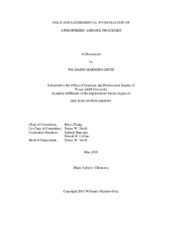| dc.description.abstract | Atmospheric aerosols profoundly impact human health, visibility, the ecosystem, and the climate. Some aerosols are directly emitted, but a majority are formed in the atmosphere by the oxidation of gaseous precursors. However, there are considerable uncertainties concerning the aerosol formation, transformation, and properties at the molecular level.
In my doctoral research, a series of laboratory measurements were conducted to investigate scientific questions, including the relation between the ambient aerosol mass concentration and light extinction, the sulfate formation under polluted environments, the light-absorption by organic aerosols under aqueous environments, the aerosol reactivity in surface reactions, and the aerosol physicochemical properties. To investigate them a series of analytical techniques were used in several scales.
For the field study, the aerosol mass concentration and aerosol light extinction were chemically apportioned with the carbonaceous aerosols being the dominant species for both. Moreover, due to the high concentration of ammonium cations relative to nitrate and sulfate anions, the low visibility, and the high relative humidity, chamber experiments were conducted to study the sulfate formation by mimicking the polluted conditions in China. It turns out that the secondary inorganic sulfate is formed by the oxidation of sulfur dioxide by nitrogen dioxide under aqueous phase. Additionally, under aqueous phase, secondary organic aerosols could be formed as showed by the bulk mixtures of α-dicarbonyls and amines model, which subsequently alter the optical properties. Furthermore, the uptake of gaseous amines and solid organic diacids reactions is studied
using a flow reactor. The results reveal that this type of heterogeneous reactions is driven by an interplay between the steric effect and the acidity/basicity strength of both the diacids and the amines.
Overall, the results indicate that atmospheric processes can efficiently alter the chemical composition, and the physical and optical properties. Detailed discussion and the further implications to the air quality and climate are presented in this dissertation. Reducing the gap in knowledge on the atmospheric aerosol process has significant implications for the development and improvement of climate-related policies and risk assessments worldwide. | en |


